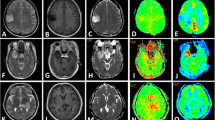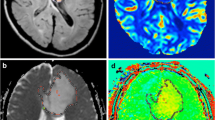Abstract
Purpose
To evaluate the role of amide proton transfer–weighted (APT-w) magnetic resonance imaging (MRI) in differentiating neoplastic and infective mass lesions using different contrast normalizations, region of interest (ROI) selection, and histogram analysis.
Procedures
Retrospective study included 32 treatment-naive patients having intracranial mass lesions (ICMLs): low-grade glioma (LGG) = 14, high-grade glioma (HGG) = 10, and infective mass lesions = 8. APT-w MRI images were acquired along with conventional MRI images at 3 T. APT-w contrast, corrected for B0-field inhomogeneity, was computed and optimized with respect to different types of normalizations. Different ROIs on lesion region were selected followed by ROI analysis and histogram analysis. Statistical analysis was performed using Shapiro-Wilk’s test, t tests, ANOVA with Tukey’s post hoc test, and receiver operation characteristic (ROC) analysis.
Results
ICMLs showed significantly (p < 0.01) higher APT-w contrast in lesion compared with contralateral side. There was a substantial overlap between mean APT-w contrast of neoplastic and infective mass lesions as well as among different groups of ICMLs irrespective of ROI selection and normalizations. APT-w contrast (using type 4 normalization: normalized with reference signal at negative offset frequency and APT-w contrast in normal-appearing white matter) reduced variability of APT-w contrast across different subjects, and overlap was less compared with other types of normalizations. There was a significant difference (p < 0.05) between neoplastic and infective mass lesions using t test for different histogram parameters of type 4 normalized APT-w contrast. ANOVA with post hoc showed significant difference (p < 0.05) for different histogram parameters of APT-w contrast (Type 4 normalization) between LGG and HGG, LGG, and infective mass lesion. Histogram parameters such as standard deviation, mean of top percentiles, and median provided improved differentiation between neoplastic and infective mass lesions compared with mean APT-w contrast. A greater number of histogram parameters of type 4 normalized APT-w contrast corresponding to active lesion region can significantly differentiate between ICMLs than other types of normalizations and ROIs.
Conclusions
APT-w contrast using type 4 normalization and active lesion region (ROI-2) should be used for studying APT. APT-MRI should be combined with other MRI techniques to further improve the differential diagnosis of ICMLs.





Similar content being viewed by others
References
Zhao X, Wen Z, Zhang G, Huang F, Lu S, Wang X, Hu S, Chen M, Zhou J (2013) Three-dimensional turbo-spin-echo amide proton transfer MR imaging at 3-tesla and its application to high-grade human brain tumors. Mol Imaging Biol 15:114–122
Sherry AD, Woods M (2009) Chemical exchange saturation transfer contrast agents for magnetic resonance imaging. Annu Rev Biomed Eng 10:391–411
Vinogradov E, Sherry AD, Lenkinski RE (2013) CEST: from basic principles to applications, challenges and opportunities. J Magn Reson 229:155–172
Liu G, Song X, Chan KWY, Mcmahon MT (2013) Nuts and bolts of chemical exchange saturation transfer MRI. NMR Biomed 26:810–828
Ward KM, Aletras AH, Balaban RS (2000) A new class of contrast agents for MRI based on proton chemical exchange dependent saturation transfer (CEST). J Magn Reson 143:79–87
Van Zijl PCM, Yadav NN (2012) Chemical exchange saturation transfer (CEST): what is in a name and what isn’t? Magn Reson Med 65:927–948
Zhou J, Lal B, Wilson DA, Laterra J, van Zijl PCM (2003) Amide proton transfer (APT) contrast for imaging of brain tumors. Magn Reson Med 50:1120–1126
Zhou J, Payen JF, Wilson DA et al (2003) Using the amide proton signals of intracellular proteins and peptides to detect pH effects in MRI. Nat Med 9:1085–1090
Zhou J, Yan K, Zhu H (2008) A simple model for understanding the origin of the amide proton transfer MRI signal in tissue. Magn Reson Med 45:788–802
Zhou J, Heo H, Knutsson L, Van Zijl PCM, Jiang S (2019) APT-weighted MRI: techniques, current neuro applications, and challenging issues. J Magn Reson Imaging: https://doi.org/10.1002/jmri.26645
Wen Z, Hu S, Huang F, Wang X, Guo L, Quan X, Wang S, Zhou J (2010) MR imaging of high-grade brain tumors using endogenous protein and peptide-based contrast. NeuroImage 51:616–622
Sun PZ, Cheung J, Wang E, Lo E (2011) Association between pH-weighted endogenous amide proton chemical exchange saturation transfer MRI and tissue lactic acidosis during acute ischemic stroke. J Cereb Blood Flow Metab 31:1743–1750
Sun PZ, Murata Y, Lu J, Wang X, Lo EH, Sorensen AG (2008) Relaxation-compensated fast multislice amide proton transfer (APT) imaging of acute ischemic stroke. Magn Reson Med 59:1175–1182
Jiang S, Yu H, Wang X, Lu S, Li Y, Feng L, Zhang Y, Heo HY, Lee DH, Zhou J, Wen Z (2016) Molecular MRI differentiation between primary central nervous system lymphomas and high-grade gliomas using endogenous protein-based amide proton transfer MR imaging at 3 tesla. J Eur Radiol 26:64–71
Togao O, Yoshiura T, Keupp J, Hiwatashi A, Yamashita K, Kikuchi K, Suzuki Y, Suzuki SO, Iwaki T, Hata N, Mizoguchi M, Yoshimoto K, Sagiyama K, Takahashi M, Honda H (2014) Amide proton transfer imaging of adult diffuse gliomas: correlation with histopathological grades. Neuro-Oncology 16:441–448
Jones CK, Schlosser MJ, Van Zijl PCM et al (2006) Amide proton transfer imaging of human brain tumors at 3T. Magn Reson Med 56:585–592
Debnath A, Sahoo P, Gupta P, Gupta RK, Singh A (2016) APT MRI of intracranial mass lesions at 3T and comparison with perfusion parameters. Proceedings of International Society for Magnetic Resonance in Medicine (ISMRM): 24th Annual Meeting & Exhibition, May 7-13, Singapore, program number 3712
Togao O, Hiwatashi A, Yamashita K, Kikuchi K, Keupp J, Yoshimoto K, Kuga D, Yoneyama M, Suzuki SO, Iwaki T, Takahashi M, Iihara K, Honda H (2017) Grading diffuse gliomas without intense contrast enhancement by amide proton transfer MR imaging: comparisons with diffusion and perfusion-weighted imaging. Eur Radiol 27:578–588
Sakata A, Okada T, Yamamoto A, Kanagaki M, Fushimi Y, Okada T, Dodo T, Arakawa Y, Schmitt B, Miyamoto S, Togashi K (2015) Grading glial tumors with amide proton transfer MR imaging: different analytical approaches. J Neuro-Oncol 122:339–348
Bai Y, Lin Y, Zhang W et al (2015) Noninvasive amide proton transfer magnetic resonance imaging in evaluating the grading and cellularity of gliomas. Oncotarget 8:5834–5842
Law M, Yang S, Wang H, Babb JS, Johnson G, Cha S, Knopp EA, Zagzag D (2003) Glioma grading: sensitivity, specificity, and predictive values of perfusion MR imaging and proton MR spectroscopic imaging compared with conventional MR imaging. Am J Neuroradiol 24:1989–1998
Singh A, Cai K, Haris M, Hariharan H, Reddy R (2013) On B 1 inhomogeneity correction of in vivo human brain glutamate chemical exchange saturation transfer contrast at 7T. Magn Reson Med 69:818–824
Kang Y, Choi SH, Kim KG (2011) Gliomas: histogram analysis of apparent diffusion coeffi cient maps with standard- or high- b-value diffusion-weighted MR imaging—correlation with tumor grade. Neuroradiology 261:882–890
Law M, Young R, Babb J, Pollack E, Johnson G (2007) Histogram analysis versus region of interest analysis of dynamic susceptibility contrast perfusion MR imaging data in the grading of cerebral gliomas. Am J Neuroradiol 28:761–766
Just N (2014) Improving tumour heterogeneity MRI assessment with histograms. Br J Cancer 111:2205–2213
Tee YK, Donahue MJ, Harston GWJ et al (2013) Quantification of amide proton transfer effect pre- and post-gadolinium contrast agent administration. J Magn Reson Imaging 40:832–838
Zhu H, Jones CK, Van Zijl PCM et al (2010) Fast 3D chemical exchange saturation transfer (CEST) imaging of the human brain. Magn Reson Med 64:638–644
Zhou J, Zhu H, Lim M, Blair L, Quinones-Hinojosa A, Messina SA, Eberhart CG, Pomper MG, Laterra J, Barker PB, van Zijl PCM, Blakeley JO (2013) Three-dimensional amide proton transfer MR imaging of gliomas: initial experience and comparison with gadolinium enhancement. J Magn Reson Imaging 38:1119–1128
Kim M, Gillen J, Landman BA, Zhou J, van Zijl PCM (2009) Water saturation shift referencing (WASSR) for chemical exchange saturation transfer (CEST) experiments. Magn Reson Med 61:1441–1450
Zaiss M, Schmitt B, Bachert P (2011) Quantitative separation of CEST effect from magnetization transfer and spillover effects by Lorentzian-line-fit analysis of z-spectra. J Magn Reson 211:149–155
Mehnert A, Jackway P (1997) An improved seeded region growing algorithm. Pattern Recogn Lett 18:1065–1071
Zhou J, Tryggestad E, Wen Z, Lal B, Zhou T, Grossman R, Wang S, Yan K, Fu DX, Ford E, Tyler B, Blakeley J, Laterra J, van Zijl PCM (2011) Differentiation between glioma and radiation necrosis using molecular magnetic resonance imaging of endogenous proteins and peptides. Nat Med 17:130–134
Park JE, Kim HS, Park KJ, Kim SJ, Kim JH, Smith SA (2016) Pre and posttreatment glioma: comparison of amide proton transfer imaging with MR spectroscopy for biomarkers of tumor proliferation. Radiology 278:514–523
Debnath A, Gupta RK, Singh A (2019) To evaluate the role of APT-w contrast, optimized for normalization and ROIs selection, in differentiating infective and neo-plastic mass lesions. Proceedings of International Society for Magnetic Resonance in Medicine (ISMRM): 27th Annual Meeting & Exhibition, April 11-16, Canada, program number 4347
Jiang S, Zou T, Eberhart CG, Villalobos MAV, Heo HY, Zhang Y, Wang Y, Wang X, Yu H, du Y, van Zijl PCM, Wen Z, Zhou J (2017) Predicting IDH mutation status in grade II gliomas using amide proton transfer-weighted (APTw) MRI. Mag Reson Med 78:1100–1109
Yu H, Wen X, Wu P et al (2019) Can amide proton transfer–weighted imaging differentiate tumor grade and predict Ki-67 proliferation status of meningioma? Eur Radiol 18:1–9
Cai K, Singh A, Popatni H et al (2015) CEST signal at 2ppm (CEST@2ppm) from Z-spectral fitting correlates with creatine distribution in brain tumor. NMR Biomed 28:1–8
Debnath A, Singh A (2017) Lorentzian probabilistic sum based Z-spectrum fitting approach for computing CEST and NOE contrast and its comparison with lorentzian sum and asymmetry analysis. Proceedings of International Society for Magnetic Resonance in Medicine (ISMRM): 25th Annual Meeting & Exhibition, April 22-27, Hawaii, program number 1975
Zaiss M, Xu LZ, Goerke S et al (2014) Inverse Z-spectrum analysis for spillover, MT and T1-corrected steady-state pulsed CEST-MRI-application to pH-weighted MRI of acute stroke. NMR Biomed 27:240–252
Goerke S, Soehngen Y, Deshmane A et al (2019) Relaxation-compensated APT and rNOE CEST-MRI of human brain tumors at 3T. Magn Reson Med 00:1–11
Acknowledgments
The authors acknowledge Philips India Limited for technical support in MRI data acquisition. The authors thank Dr. Jinyuan Zhou, Dr. Peter C.M. Van Zijl, and Dr. Indrajit Saha for APT sequence and Dr. Mamta Gupta for editing manuscript. The authors also thank Dr. Sunita Ahlawat and Dr. Rana Patir for pathological information.
Funding
This work was supported by MATRICS scheme, Science and Engineering Research Board, Department of Science and Technology (SERB-DST) grant number MTR_2017_001021 for overall study and National Institutes of Health (NIH) grants P41 EB015909 for APT pulse sequence.
Author information
Authors and Affiliations
Corresponding author
Ethics declarations
Conflict of Interest
The authors declare that they have no conflict of interest.
Additional information
Publisher’s Note
Springer Nature remains neutral with regard to jurisdictional claims in published maps and institutional affiliations.
Electronic Supplementary Material
ESM 1
(PDF 238 kb)
Rights and permissions
About this article
Cite this article
Debnath, A., Gupta, R.K. & Singh, A. Evaluating the Role of Amide Proton Transfer (APT)–Weighted Contrast, Optimized for Normalization and Region of Interest Selection, in Differentiation of Neoplastic and Infective Mass Lesions on 3T MRI. Mol Imaging Biol 22, 384–396 (2020). https://doi.org/10.1007/s11307-019-01382-x
Published:
Issue Date:
DOI: https://doi.org/10.1007/s11307-019-01382-x




